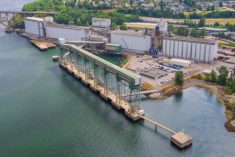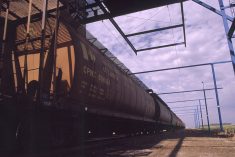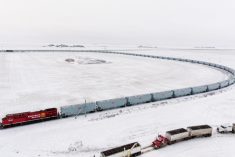The federal Transportation Safety Board’s report into the fatal derailment of a Canadian Pacific Railway (CP) grain train in the Rocky Mountains in 2019 calls for changes to train braking systems and maintenance.
CP, however, is questioning the TSB’s conclusions about the braking performance of the train involved, saying those conclusions are “based on inappropriate extrapolation of data and unsupported inferences.”
The TSB on Thursday released its report into the Feb. 4, 2019 crash near Field, B.C., in which two of three locomotives and 99 cars from a 112-car train of loaded grain hopper cars derailed and crashed in steep mountain terrain, killing the three members of the train’s relief crew.
Read Also

More Canadian companies at Agritechnica 2025
A record number of Canadian agriculture machinery and tech companies are at Agritechnica 2025, with exporters being more aggresive looking for new markets.
“This tragic accident demonstrates, once again, that uncontrolled movements of rolling stock continue to pose a significant safety risk to railway operations in Canada,” TSB chair Kathy Fox said Thursday in a release.
“It is obvious that more must be done to reduce the risks to railway employees and the Canadian public, reduce preventable loss of life, and increase the safety and resilience of this vital part of the Canadian supply chain.”
The TSB, in its report, calls on Transport Canada to establish “enhanced test standards and requirements for time-based maintenance” of brake cylinders on freight cars operating on steep descending grades in cold ambient temperatures.
It also calls on the transport department to require Canadian railways to “develop and implement a schedule for the installation of automatic parking brakes on freight cars,” putting a priority on retrofits for cars used in “bulk commodity unit trains in mountain grade territory.”
It also asks Transport Canada to require CP “demonstrate that its safety management system can effectively identify hazards arising from operations using all available information, including employee hazard reports and data trends; assess the associated risks; and implement mitigation measures and validate that they are effective.”
According to the TSB’s report, the train was westbound on CP’s Laggan subdivision, which runs from Calgary to Field, about 20 km west of Lake Louise. It started to descend the Field Hill just after 9:30 p.m. on Feb. 3, and while on the “steepest part of the grade,” it wasn’t able to keep its speed below at or below the 15-mph limit.
When the train reached 21 mph, the crew, following operating procedure, stopped the train using its emergency brakes at Partridge, B.C., with about nine miles of steep descending grade still to go. Brake cylinder pressure retaining valves were then set on 84 cars in the train.
With the inbound crew’s shift over, a relief crew was called in to complete the trip to Field, but that crew was delayed in arriving until about 12:20 a.m., by which time the temperature was -28 C and the train’s air brake system “had been leaking compressed air, reducing the brakes’ capacity to hold the train on the steep grade,” the TSB said.
The brake cylinders’ leakage, the TSB said, was “a situation made worse by their age and condition, and exposure to extreme cold temperatures over time” and “after being stationary on the hill for around three hours, air leakage reached a critical threshold and the brakes could no longer hold the train on the steep grade.”
Before the relief crew could start the process to get the train underway again, the train “began to creep forward, gradually accelerating uncontrolled down the steep grade.” The TSB said the relief conductor and conductor trainee left the cab at that point planning to apply hand brakes to try and stop or slow the train but were instead called back to the cab moments later by the engineer for their safety.
The train was able to make its way around back-to-back reverse curves, but eventually accelerated to 53 mph, “was not able to negotiate” a sharp curve right before the Kicking Horse River bridge, and derailed.
The TSB said it identified “a number of safety deficiencies” contributing to the crash, including the “degradation” of air brake systems in extreme cold temperatures; the “limitations” of current train brake test methodologies to account for such conditions; and the need for “additional physical defences” to prevent such uncontrolled movements.
Crew training, the TSB said, was “not specific to the unique operating conditions of the Laggan subdivision. The board also called out the “inadequacy of experience of employees supervising mountain-grade operations on this subdivision.”
The TSB also pointed to a “need for better identification of hazards through reporting, data trend analysis, and risk assessments under CP’s safety management system to support risk mitigation measures.”
‘Fully-trained’
CP, in its statement Thursday, replied that both the locomotive engineers of the inbound crew and the relief crew were “fully-trained, qualified and certified, and were well-experienced in the handling of trains on mountain grades,” and the trainmaster was also “a qualified locomotive engineer with experience on mountain grades.”
Both crews and the trainmaster “agreed on the appropriate steps to be taken in line with existing procedure,” CP said, adding that operating procedure for that specific hill was based on practices set up following “previous incidents” over two decades earlier. “This was not an issue of training and/or experience.”
CP, in Thursday’s statement, said the TSB “has erroneously concluded, based on inappropriate extrapolation of data and unsupported inferences, that the involved train exhibited poor braking performance.”
The board’s report, the company said, confirms the train “was fully functional, met all industry standards and passed all regulatory brake test inspections.”
CP further said its safety management system meets regulations and there were “no systemic hazards that were not appropriately addressed” by that system, including Field Hill train braking performance.
Given “the gravity of this incident and the tragic loss of life, it was extremely disappointing that the TSB misrepresented the facts at today’s news conference and misunderstood key facts about the incident in its report,” the company said.
CP said Thursday it would be talking to the TSB directly about those “inaccuracies and misrepresentations,” and also noted the crash is still the subject of a preliminary inquiry by RCMP. — Glacier FarmMedia Network















